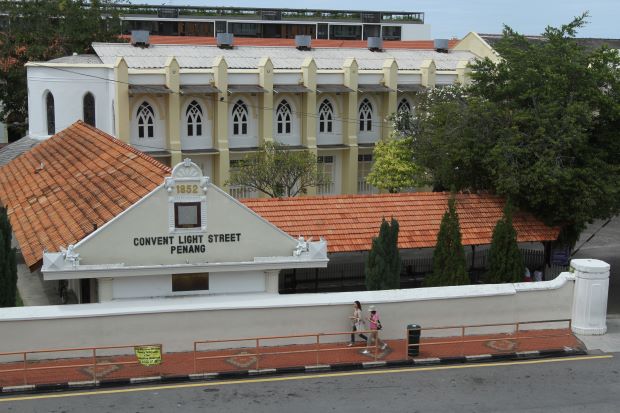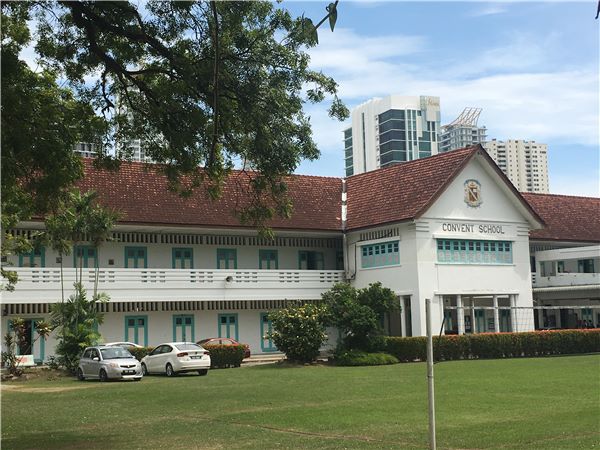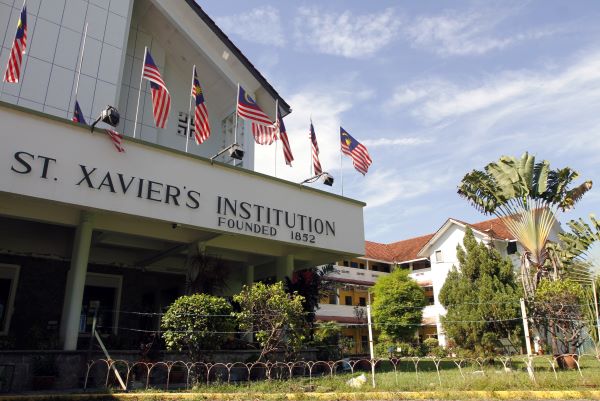
Convent Light Street in Penang.
THREE convent schools in Penang are in the news with talk that they may have to close down, supposedly because of dwindling enrolment.
Naturally, this has become unsettling because Penangites are very sentimental, even emotional, about these historic institutions.
I spent over a decade at St Xavier’s Institution, and I regard Convent Light Street as a sister school, as both schools sit side by side.
Many friendships were forged with CLS students, and those who qualified for Sixth Form studies, enrolled in SXI after completing their Form Five examinations.
CLS is also the oldest girls’ school in South-East Asia, standing proudly on its present site within the Unesco Heritage Zone since 1859.
The school was founded in 1852 by three French Catholic nuns from the Holy Infant Jesus Mission, who were part of a group of six who left France for Singapore in 1851 to set up a Catholic institution on the island.
According to an article by Louise Goss-Custard, the 30-year-old Mother Superior who led the group, died during the five-month journey, and the only remaining English-speaking sister decided to leave the order upon reaching Singapore.
“Another sister became seriously ill with ‘brain fever’ during the journey and remained ill for the rest of her life. Now too small a group to be effective in Singapore, the Sisters were sent to Penang, where the La Salle Brothers were already active and could support them until reinforcements arrived,” she wrote.
Penang founder Captain Francis Light had set up his administration where the CLS is now located, and for a while, Sir Stamford Raffles worked there before he moved on to Singapore.
Apparently, Raffles spent more time in Penang than in Singapore. He arrived in Penang – which was then known as the Prince of Wales island – in 1805 to work under Philip Dundas, the then-governor of Penang.
Fast-forward to today, the landowner – the Sisters of the Infant Jesus (a Catholic order) – has written to the Education Ministry asking for the return of the land where SK Convent Light Street, SMK Convent Light Street and SMK Convent Pulau Tikus are located.
Sister Celina Wong, the spokesperson, has assured that they have no intention of selling the land or buildings for redevelopment.
Beyond that, the sisters are not saying anything, though the reality remains that enrolment has dropped.
This is not the first time as the 124-year-old SK Pykett Methodist faced the same problem before. The school will be closed once its final term ends in 2019, and it won’t be around to show that there are now more teachers than students.
The Methodist Church in Malaysia revealed its education council had been in talks with the Education Ministry to phase out the school since 2010.
The authorities finally decided that SK Pykett Methodist Penang would be wound down gradually in five years (2015-2020).

View of main building of Sekolah Menengah Kebangsaan Convent Pulau Tikus.
Pykett Methodist School is a spin-off from the Methodist Boys School, which was formerly known as the Anglo-Chinese School, and was named after Methodist missionary G.F. Pykett, who was instrumental in the growth of education in Penang.
The school’s enrolment has been dwindling over the years, a scenario which the Methodist Church had described as “a phenomenon that seems to affect schools located within the city – not only in Penang but in other urban centres of the country too.”
The fate of the three Convent schools would probably be similar to that of Pykett. There is no question that the Sisters of the Infant Jesus have the best interest of the schools at heart and it must be tormenting them, having to deliberate the future of the schools and the challenges facing this institution.
They should seek the help of its illustrious alumnus, many of whom have strong business experience in the corporate sector, including in education.
The education field, like all sectors, is no different, and stakeholders obviously have to fine-tune their strategy to make new plans to continue with their mission.
It is good that Sister Wong has assured that the sisters have stood by their “objective of providing a wholesome education in our mission schools”.
The sisters may need to consider converting the schools into affordable private international institutions, since there is huge demand for quality education.
Chinese vernacular schools have gained traction, even among the non-Chinese, because they have earned a reputation for quality teaching, the reality being that Malaysians understand the economic value of Mandarin, with China now a superpower.
The mission schools set up in early Malaya, and later Malaysia, were popular, the importance of English and England’s economic position apparent to many. It is still the global lingua franca.
But there are reasons why well-intentioned Penangites are concerned over the fate of the three Convents.
Convent Seremban is an example. It was founded in 1904, but in 1994, the primary and secondary schools were demolished and relocated.
According to a news report, billboards were erected at the site for an underground car park and multi-storey shopping complex.
However, it has been more than 20 years since the school was demolished and nothing has substituted it. There is still a huge pond there, which has become an eyesore.
Meanwhile, the relocated Convent Seremban has been renamed SK Puteri and SMK Puteri, a legacy effectively wiped out.
But there are also instances where relocation was the best option. When the College General was moved by its owners, Penangites were outraged.
The 350-year-old College General, located on Gurney Drive then, was an institution to train Catholic priests and has since produced more than 1,000 men of cloth. Most of them returned to serve in their native countries in many parts of Asia.
Many products of the College General were Vietnamese who were later killed for their faith and eventually canonised and beatified by Rome.
The College General has a record of having two professors and five seminarians canonised, or declared saints, by the Vatican, and 50 others beatified, or declared by the Pope as one of the faithful who lived a holy life and/or died a martyr’s death.
But in the early 1980s, the La Salle Brothers vacated the Gurney Drive premises, with the site taken over by the International School of Penang (Uplands). Finally, in 2004, a property developer bought this piece of land for RM97.86mil from the La Salle Brothers to build a high-rise retail outlet and residential project.
Unfortunately, the site was too big, so, student enrolment shrunk, and today, the seminary is located at the nearby Mount Miriam.
The founders of these mission schools and institutions have played an integral role in our education system, producing millions of students, and key Malaysian personalities today.
It is open to debate, but some opine that many of our schools today can’t match the quality of education at these mission schools.








